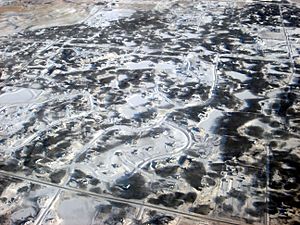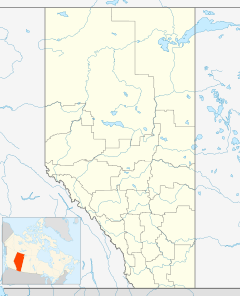Bearspaw, Alberta facts for kids
Quick facts for kids
Bearspaw
|
|
|---|---|

Acreages of Bearspaw
|
|
| Country | Canada |
| Province | Alberta |
| Municipal district | Rocky View County |
| Established | 1879 |
| Government | |
| • Type | Un-incorporated |
| Elevation | 1,105 m (3,625 ft) |
| Population | |
| • Total | 5,567 |
| Time zone | UTC-7 (MST) |
| Zip Code |
T3L
|
Bearspaw is a rural area in southern Alberta, Canada. It's part of Rocky View County and has about 5,567 people living there (as of 2018).
Long ago, the Niitsitapi or Blackfoot nation lived in the Bearspaw area. This nation included four main tribes: the Siksika, Piegan Blackfeet, Piikani Nation, and Kainai (also called Blood Indians).
Bearspaw is located near some bigger cities. To its southeast is the City of Calgary. To its west, you'll find the Town of Cochrane, right along Highway 1A. Bearspaw is north of the Bow River and east of the Glendale Community within Rocky View County.

For schooling, Bearspaw is part of the Rocky View Schools system. Kids from kindergarten to grade 8 go to Bearspaw School. Older students, from grades 9 to 12, attend Cochrane High School. If you love hockey, Bearspaw is part of the Cochrane Minor Hockey Association for local leagues.
Contents
What's the History of Bearspaw?
The area officially got its name, Bearspaw, in 1909 when the Canadian Pacific Railway Station was built. The name comes from a very important leader of the Stoney Nations, Chief Masgwaahsid, who was also known as Bears Paw.
Chief Masgwaahsid was famous for being a delegate. He met with representatives of the Queen of Britain on September 22, 1877. They signed something called Treaty No. 7. This treaty involved five different First Nations tribes: the Stoney-Nakoda, Piikani (Peigan), Kainnai (Blood), Tsuut'ina (Sarcee), and the Siksika (Blackfoot). The treaty set aside land for the native people, with the amount depending on family size. Payments were also made to each person, both right away and every year. The government also gave tools and cattle to each family.
Dairy farmers were the first to settle in Bearspaw. The first schoolhouse was built in 1920. It had just one classroom and was used for 45 years until it closed in 1965. Over time, more people moved to Bearspaw. They built ranches, farms, planned neighborhoods, and large private properties.
What's the Weather Like in Bearspaw?
Bearspaw has an average yearly temperature of about 3.1 degrees Celsius (37.6 degrees Fahrenheit). The warmest month is usually July, with an average temperature of 14.8 degrees Celsius (58.6 degrees Fahrenheit). January is the coldest month, averaging -8.2 degrees Celsius (17.2 degrees Fahrenheit).
On average, Bearspaw gets about 469.9 millimeters (18.5 inches) of rain and snow each year. June is usually the wettest month, with about 106.7 millimeters (4.2 inches) of precipitation. January is the driest, with only about 10.2 millimeters (0.4 inches). Bearspaw also gets a good amount of snow, averaging 125 centimeters (49 inches) per year. March often has the most snowfall, with about 21.6 millimeters (0.85 inches) on average.
How Does Bearspaw Get Electricity?
In 1954, a hydroelectric power plant was built in Bearspaw. Its main goal was to stop the Bow River from flooding Calgary during winter and prevent ice from building up. This plant produces about 70,000 megawatt hours of electricity each year.
The company TransAlta built this power plant. It was the last one added along the Bow River in Alberta. TransAlta runs four hydro plants on the Bow River, which together form the Bow Rivers Electric System. This system helps provide a steady supply of electricity, especially when a lot of power is needed, helping to prevent shortages.
Fun Parks and Outdoor Activities
Bearspaw has some great places for outdoor fun!
- The RGE RD 30 leads to the Bearspaw Loop. This is a natural area with a walking path that goes through local habitats.
- Big Hill Springs Provincial Park is northeast of Cochrane. It has natural foothills, parklands, and a cool series of waterfalls.
- Glenbow Ranch Provincial Park is huge, with over 1,300 hectares of parkland. It's located between Calgary and Cochrane, along the north side of the Bow River.
- The Twelve Mile Coulee is northwest of Calgary, near Tuscany. It's a 190-hectare natural park with many hiking trails.
What Plants Grow in Bearspaw?
Bearspaw is home to many interesting plants and trees:
- Jack Pine (Pinus banksiana): This tree is usually 5-10 meters tall, but can grow up to 20 meters. It has reddish-brown bark and yellowish-green leaves that are about 2-4 cm long.
- Manitoba Maple (Acer negundo): This tree can grow up to 12 meters tall. It has rough grey bark and light green twigs covered in fine hairs.
- Laurel Leaf Willow (Salix pentandra): This can be a small tree or a shrub. It has grayish-brown bark and long, flexible branches. It's one of the first trees to get leaves in spring and one of the last to lose them in autumn.
- Balsam Fir (Abies balsamea): This tree can reach 18 meters tall. Its leaves are about 18-25 mm long and can be jagged or rounded at the tip.
- Beaked Hazelnut (Corylus cornuta): This is a shrub that grows 1-3 meters tall. Its leaves are oval to heart-shaped at the base. It flowers in early spring.
- Tamarack (Larix laricina): This medium-sized tree usually grows to about 20 meters. Older Tamaracks have scaly, reddish-brown bark, while young ones have smooth, grey bark. Its pale green leaves turn bright yellow in the fall.
- Lodgepole Pine (Pinus contorta): This is a tall tree, often 20-30 meters high. Its leaves grow in thick clusters at the ends of twigs and are usually longer and less curled than Jack Pine leaves.
- Pink False Dandelion (Agoseris lackschewitzii): These flowers are pink when they are buds and when they bloom. They can grow 6-35 cm tall and have hairs all over them.
- Long-Leaved Arnica (Arinca longifolia): This plant has orange or yellow flowers with 8-11 petals, about 2 cm wide. Its leaves grow in pairs along the stem. It can grow 30-60 cm tall.
What Animals Live in Bearspaw?
Plant-Eating Animals (Herbivores)
- White-tail deer (Odpcoileus virginianus): These deer are known for the white fur on the underside of their tail. Their fur is reddish-brown in summer and grayish-brown in winter. Males grow antlers between summer and autumn. They usually weigh between 50 and 136 kg.
- Mule deer (Odocoileus hemionus): You can spot these deer by their black-tipped tail and large, "mule-like" ears. Males have big antlers. In Alberta, they typically weigh around 113–136 kg.
- Moose (Alces alces): Moose are the largest members of the deer family. They are easy to recognize by their huge, flat, wide antlers (on males) and large front muzzle. They are black, very big, and have long legs. Males average 450 kg, and females average 350 kg.
- Elk (Cervus canadensis): Elk are the second-largest members of the deer family, often found near the Rocky Mountains. Their fur can be dark brown in winter and reddish-brown in summer. Males have lighter fur on their rump and darker fur on their head and neck, and they grow very large antlers. Elk in Alberta weigh between 300 and 350 kg.
- North American beaver (Castor canadensis): Beavers are the largest rodents in North America, weighing 16-30 kg and growing up to 80 cm long. Their fur is grayish-brown on the outside, with thick underfur to keep them dry. They are common near rivers, lakes, streams, marshes, and ponds.
Meat-Eating Animals (Carnivores)
- Coyotes (Canis latrans): Coyotes are smaller than wolves but larger than foxes. Males weigh 9–23 kg, and females weigh 7–18 kg. They have long fur that can be grey, yellowish-brown, or reddish. They also have pointed ears, hairy tails, and a slim muzzle.
- Cougars (Puma concolor): Cougars have fur that ranges from dark brown to orangish-brown, with white fur on their throat, chest, and stomach. They are known for their long tails with a black tip and large front paws. Males typically weigh 60–100 kg, and females 35–60 kg.
- Canada lynx (Lynx canadensis): Lynx have thick, silvery-brown fur, small bodies, long legs, and short tails with a black tip. Their triangular ears have long tufts of hair. They usually weigh between 8–14 kg.
- Grizzly bears (Ursus arctos horribilis): Grizzly bears used to live in many parts of Alberta but are now mostly found in forested areas and the Rocky Mountains. They are larger than black bears and usually have lighter brown fur. They have a big shoulder hump and curved claws. They can weigh over 315 kg, with males reaching up to 770 kg and females up to 360 kg.
- American black bears (Ursus americanus): Black bears live in a wider area than grizzlies, usually in forests. They are smaller than grizzly bears, have dark fur, and straight claws. Males weigh between 115 and 270 kg, and females between 92 and 140 kg.
Birds
- Common redpolls (Carduelis flammea): These birds are easy to spot because of their bright red feathers on their forehead and black feathers on their chin. Males have a pink patch on their chest, while females do not. Both sexes weigh about 11-20g and are 12–14 cm long.
- Snowy owls (Bubo scandiacus): You might see snowy owls in Bearspaw during the winter. They have round heads, large bodies, and thick feathers. They are mostly white with brown or black spots. Females usually have more spots and are paler than males. They can weigh 1.6-2.9 kg and are 52–71 cm long.
- Bald eagles (Haliaeetus leucocephalus): Adult bald eagles have white feathers on their heads and tails, and brown feathers on their bodies. They have sharp talons and a yellow, curved beak. Males can grow to 76 cm tall and weigh 3–4 kg. Females can reach 102 cm tall and weigh up to 7 kg.
- Pine grosbeaks (Pinicola enucleator): These birds have grey feathers. Males also have red feathers, while females have yellow feathers. They usually grow to 20-20.5 cm long and weigh between 52-78g.
- Downy woodpeckers (Picoides pubescens): These woodpeckers have black wings with white spots, and black and white stripes on their heads. They have a white stripe down their chests. Males also have a red patch on the back of their heads. Both sexes weigh about 21-28g and are 14–17 cm long.





